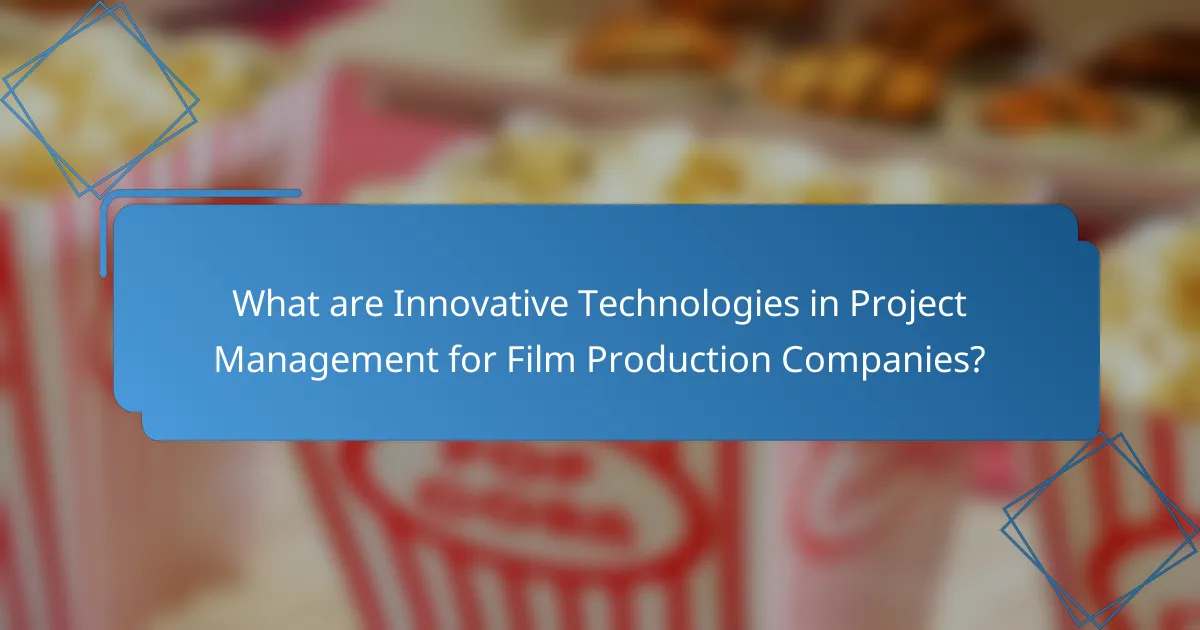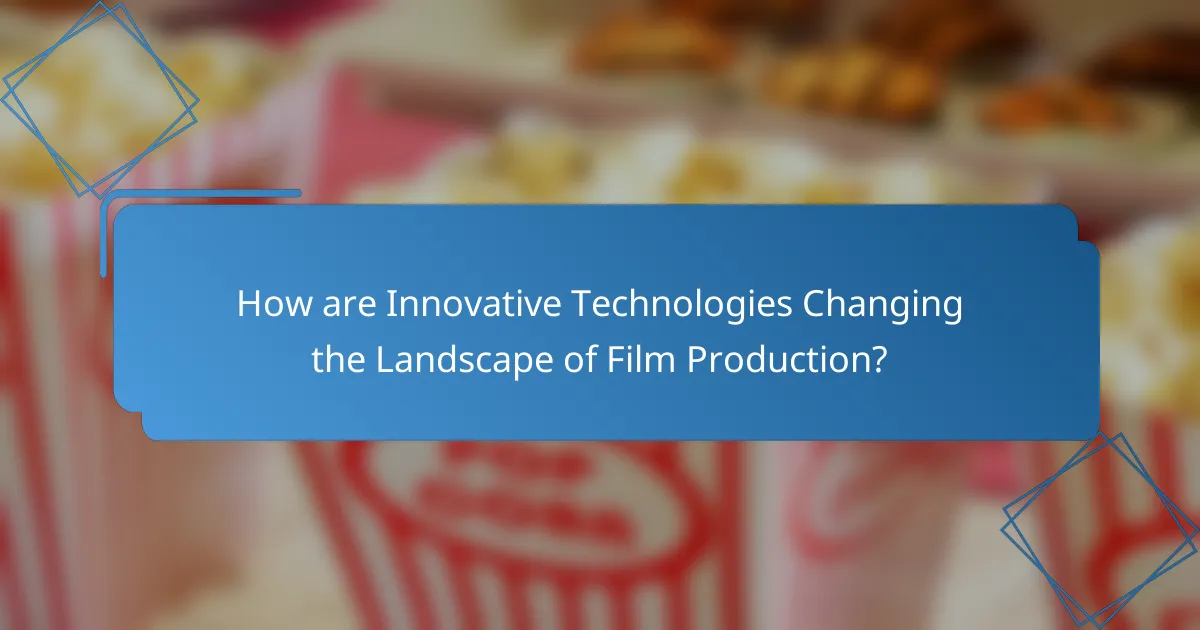Innovative technologies are transforming project management within film production companies, significantly enhancing efficiency and creativity. Key advancements include cloud-based collaboration tools that facilitate real-time communication among teams, AI-driven scheduling software that optimizes resource allocation and timelines, and virtual reality for pre-visualization, allowing filmmakers to visualize scenes before filming. These technologies streamline workflows, improve decision-making, and have been shown to reduce production time by up to 30%. Future trends indicate a continued reliance on AI, cloud tools, and VR, alongside data analytics, to further refine production management processes and elevate film quality.

What are Innovative Technologies in Project Management for Film Production Companies?
Innovative technologies in project management for film production companies include cloud-based collaboration tools, AI-driven scheduling software, and virtual reality for pre-visualization. Cloud-based tools enable real-time collaboration among teams, enhancing communication and efficiency. AI-driven scheduling software optimizes resource allocation and timelines, reducing delays. Virtual reality allows filmmakers to visualize scenes and plan shots before filming. These technologies streamline workflows and improve decision-making. For instance, a study by the Producers Guild of America highlights the impact of these tools on reducing production time by up to 30%.
How do these technologies enhance project management processes?
Innovative technologies enhance project management processes by improving efficiency and collaboration. These technologies automate routine tasks, which saves time for project managers. They also provide real-time data analytics, allowing for informed decision-making. Enhanced communication tools facilitate better team coordination and reduce misunderstandings. Cloud-based platforms enable remote access to project files, promoting flexibility. Additionally, project management software offers templates and frameworks that streamline workflows. According to a study by the Project Management Institute, organizations that utilize advanced project management tools experience a 20% increase in project success rates. This demonstrates the tangible benefits of integrating technology into project management.
What specific technologies are being utilized in film production project management?
Film production project management utilizes various specific technologies. These include project management software like Movie Magic Scheduling and Final Draft. These tools help in scheduling and scriptwriting, respectively. Collaboration platforms such as Shotgun and Frame.io facilitate team communication and asset management. Cloud storage solutions like Google Drive and Dropbox enable easy file sharing and access. Additionally, budgeting tools like StudioBinder assist in financial planning. Virtual production technologies, including Unreal Engine, enhance visualization and pre-visualization processes. Data analytics tools provide insights into project performance and resource allocation. These technologies streamline workflows and improve overall efficiency in film production.
How do these technologies improve collaboration among teams?
Innovative technologies enhance collaboration among teams by facilitating real-time communication and information sharing. Tools like project management software allow team members to track progress and assign tasks efficiently. Cloud-based platforms enable easy access to shared documents from any location. Video conferencing tools support face-to-face interaction, even when team members are remote. These technologies reduce delays in decision-making by streamlining feedback processes. According to a study by McKinsey, teams that use digital collaboration tools can improve productivity by 20-30%. This demonstrates the significant impact of technology on team collaboration in film production.
What challenges do film production companies face in project management?
Film production companies face several challenges in project management. Budget constraints often limit resources and affect decision-making. Scheduling conflicts arise due to the availability of cast and crew. Communication issues can lead to misunderstandings and delays. Technology integration poses difficulties, especially with new tools. Compliance with legal regulations adds complexity to projects. Risk management is crucial but often inadequately addressed. Lastly, maintaining creative vision while adhering to project timelines can be challenging. These factors collectively complicate the project management process in film production.
How can innovative technologies address these challenges?
Innovative technologies can address challenges in film production project management by streamlining workflows and enhancing collaboration. Project management software facilitates real-time communication among team members. This reduces delays and miscommunication, which are common challenges in film projects. Cloud-based platforms allow for centralized access to project files, improving efficiency. Automation tools can handle repetitive tasks, freeing up creative teams to focus on storytelling. Data analytics can provide insights into project performance, enabling better decision-making. Virtual reality can enhance pre-visualization, allowing filmmakers to plan scenes more effectively. These technologies collectively improve project timelines and resource allocation, leading to more successful film productions.
What are the common pitfalls in adopting new technologies?
Common pitfalls in adopting new technologies include resistance to change, inadequate training, and poor integration. Resistance to change often arises from employees fearing new systems. Inadequate training can lead to underutilization of new tools. Poor integration with existing systems can disrupt workflows. Additionally, lack of clear objectives may result in misalignment with business goals. These pitfalls can hinder the benefits of innovative technologies. Studies show that organizations with structured change management strategies see higher success rates in technology adoption.

How are Innovative Technologies Changing the Landscape of Film Production?
Innovative technologies are significantly transforming the landscape of film production. These advancements streamline various aspects of filmmaking, enhancing efficiency and creativity. Digital cameras have replaced traditional film, reducing costs and increasing accessibility. Virtual reality (VR) and augmented reality (AR) are revolutionizing storytelling techniques, allowing immersive experiences. Cloud-based project management tools facilitate collaboration among teams, regardless of location. Artificial intelligence (AI) is optimizing editing processes, saving time and resources. Additionally, data analytics provide insights into audience preferences, guiding content creation. These technologies collectively reshape production workflows and elevate the overall quality of films.
What impact do these technologies have on project timelines?
Innovative technologies significantly shorten project timelines in film production. These technologies streamline processes and enhance collaboration among teams. For instance, cloud-based project management tools enable real-time updates and communication. This leads to quicker decision-making and reduces delays. Automation tools can handle repetitive tasks, freeing up time for creative work. Additionally, advanced scheduling software optimizes resource allocation, ensuring efficient use of time. According to a study by the Project Management Institute, organizations that adopt such technologies can improve project completion times by up to 20%. This demonstrates the tangible benefits of technology in accelerating project timelines in the film industry.
How do they affect budget management in film projects?
Innovative technologies significantly affect budget management in film projects by enhancing accuracy and efficiency. These technologies, such as project management software and budgeting tools, provide real-time tracking of expenses. They allow for precise allocation of resources and forecasting of costs. This leads to better financial oversight throughout the production process. For instance, software like Movie Magic Budgeting streamlines the budgeting process, ensuring all expenses are accounted for. Additionally, cloud-based platforms facilitate collaboration among team members, reducing miscommunication and errors. As a result, projects can stay within budget more effectively. According to a study by the Producers Guild of America, projects using advanced budgeting tools reported a 20% reduction in overspending.
What role do they play in resource allocation?
Innovative technologies play a crucial role in resource allocation within film production companies. They enable efficient tracking of resources such as time, budget, and personnel. Technologies like project management software provide real-time data on resource availability. This leads to informed decision-making regarding resource distribution. For instance, cloud-based tools allow teams to collaborate effectively and allocate resources based on current project needs. According to a study by the Project Management Institute, organizations using advanced tools report 20% higher project success rates. This demonstrates the impact of technology on optimizing resource allocation in film production.
What are the benefits of using innovative technologies in film production project management?
Innovative technologies in film production project management enhance efficiency and collaboration. These technologies streamline communication among team members. They provide real-time updates on project status. This leads to quicker decision-making and problem-solving. Advanced project management software allows for better resource allocation. It minimizes delays by optimizing schedules and budgets. Data analytics tools help in tracking performance metrics. This enables teams to adjust strategies based on insights. Overall, these technologies improve workflow and increase project success rates.
How do these technologies enhance creativity and innovation?
Innovative technologies enhance creativity and innovation in film production by streamlining workflows and enabling collaboration. Tools like cloud-based software allow teams to share ideas and resources in real-time. This fosters a dynamic environment where creative concepts can evolve rapidly. Advanced editing software provides filmmakers with more options, encouraging experimentation. Virtual reality and augmented reality technologies offer immersive experiences that inspire new storytelling techniques. Data analytics tools help identify audience preferences, guiding creative decisions. According to a study by the University of Southern California, 70% of filmmakers reported increased creativity due to technology integration. This evidence shows that these technologies significantly contribute to innovative practices in film production.
What are the long-term benefits for film production companies?
Long-term benefits for film production companies include increased efficiency, enhanced collaboration, and improved project outcomes. Innovative technologies streamline workflows and reduce production time. Automation of repetitive tasks allows teams to focus on creativity. Advanced project management tools facilitate real-time communication among team members. Data analytics provide insights for better decision-making. A solid reputation can lead to more funding opportunities. Companies adopting these technologies often see a higher return on investment. Overall, these benefits contribute to sustained growth and competitiveness in the industry.

What are the Future Trends in Project Management Technologies for Film Production?
Future trends in project management technologies for film production include increased use of artificial intelligence, cloud-based collaboration tools, and virtual reality. Artificial intelligence can streamline scheduling and resource allocation, enhancing efficiency. Cloud-based tools facilitate real-time collaboration among global teams, improving communication and workflow. Virtual reality offers immersive pre-visualization techniques, aiding in creative decision-making. Data analytics is also becoming essential, allowing for informed decision-making based on production metrics. These technologies are reshaping how film productions are managed, leading to more efficient and innovative processes.
How is artificial intelligence shaping project management in film production?
Artificial intelligence is significantly shaping project management in film production by enhancing efficiency and decision-making. AI tools streamline scheduling and resource allocation, reducing time spent on administrative tasks. Predictive analytics help forecast project timelines and budgets more accurately. Machine learning algorithms analyze past projects to identify potential risks and optimize workflows. AI-driven software can automate tasks like script analysis and casting recommendations. This leads to more informed creative decisions and improved collaboration among teams. According to a 2022 report by the International Film Association, AI integration has increased productivity in film projects by up to 30%.
What are the emerging tools that filmmakers should consider?
Filmmakers should consider tools like virtual reality (VR) for immersive storytelling. VR allows for unique audience engagement and creative exploration. Another emerging tool is artificial intelligence (AI) for script analysis and casting. AI can enhance decision-making in pre-production. Cloud-based project management software is also significant. It facilitates real-time collaboration among teams. Drones are becoming essential for aerial cinematography. They offer cost-effective solutions for capturing stunning visuals. Finally, 360-degree cameras are gaining popularity for creating interactive content. These tools are reshaping the filmmaking landscape and improving production efficiency.
How can virtual and augmented reality enhance project management?
Virtual and augmented reality can enhance project management by improving visualization and collaboration. These technologies allow teams to create immersive environments for project planning and design. For instance, stakeholders can visualize sets and scenes in 3D before actual production begins. This reduces misunderstandings and miscommunications.
Additionally, virtual reality simulations can train team members in a risk-free environment. This leads to more efficient workflows and better preparedness. Augmented reality can overlay digital information onto physical spaces, aiding real-time decision-making.
According to a study by PwC, VR in project management can reduce costs by up to 30% by minimizing errors. Furthermore, 70% of project managers reported improved team collaboration through these technologies. These statistics validate the effectiveness of virtual and augmented reality in enhancing project management.
What best practices should film production companies follow when implementing these technologies?
Film production companies should adopt a structured approach when implementing innovative technologies. First, they must assess their specific project needs and identify suitable technologies. This ensures alignment between technology capabilities and project requirements. Second, training for staff is essential to maximize technology usage. Well-trained personnel can leverage technology effectively, improving overall productivity.
Third, companies should establish clear communication channels among all team members. This fosters collaboration and ensures everyone is on the same page regarding technology integration. Fourth, they need to monitor and evaluate technology performance regularly. This allows for timely adjustments and improvements based on feedback and results.
Lastly, staying informed about industry trends and emerging technologies can provide a competitive edge. Engaging in continuous learning helps companies adapt to evolving project management demands. Implementing these best practices can lead to enhanced efficiency and successful project outcomes in film production.
How can companies ensure successful technology adoption?
Companies can ensure successful technology adoption by implementing a structured change management process. This involves assessing the needs of the organization and selecting technologies that align with those needs. Training employees on new technologies is crucial for effective adoption. Providing ongoing support and resources helps to address challenges as they arise. Encouraging feedback from users can lead to improvements in technology use. Additionally, establishing clear goals and metrics for success can guide the adoption process. Research indicates that organizations with a defined strategy for technology adoption experience higher success rates. For example, a study by Prosci found that effective change management increases project success rates by 6 times.
What training is necessary for teams to effectively use these technologies?
Teams require specialized training in project management software, collaboration tools, and data analytics to effectively use innovative technologies in film production. This training should cover the specific features and functionalities of the technologies being implemented. Additionally, hands-on workshops can enhance practical skills and facilitate real-time problem-solving. Training should also include best practices for integrating these technologies into existing workflows. Regular updates and refresher courses can help teams stay current with technological advancements. Research by the Project Management Institute indicates that organizations with well-trained teams experience a 20% increase in project success rates.
Innovative technologies are fundamentally transforming project management in film production companies. This article explores the impact of cloud-based collaboration tools, AI-driven scheduling software, and virtual reality on enhancing efficiency, collaboration, and decision-making in film projects. Key challenges faced by production companies, such as budget constraints and communication issues, are addressed, along with how these technologies provide solutions. Additionally, the article highlights best practices for technology adoption and training necessary for teams to maximize the benefits of these advancements, ultimately leading to improved project outcomes and creativity in filmmaking.